
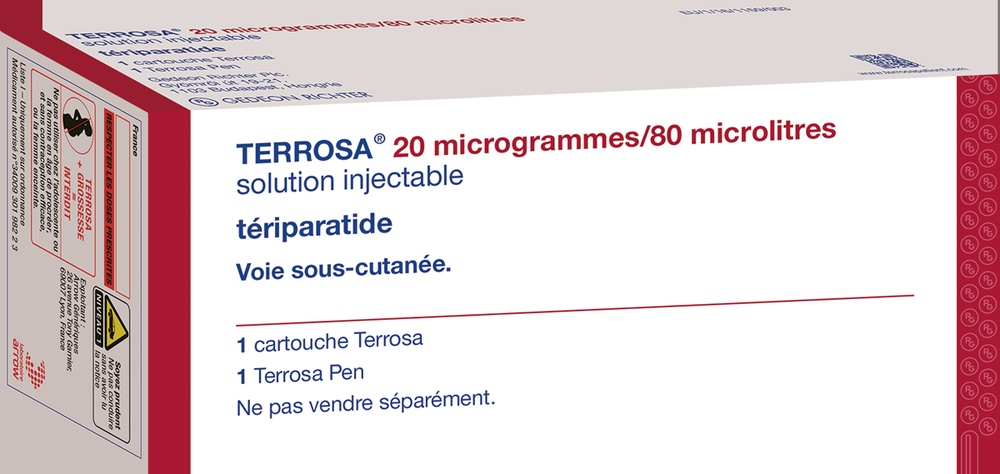
ТЕРРОСА 20 микрограмм/80 микролитров раствор для инъекций в предварительно заполненной шприц-ручке

Спросите врача о рецепте на ТЕРРОСА 20 микрограмм/80 микролитров раствор для инъекций в предварительно заполненной шприц-ручке

Инструкция по применению ТЕРРОСА 20 микрограмм/80 микролитров раствор для инъекций в предварительно заполненной шприц-ручке
Введение
Инструкция: информация для пользователя
Терроса 20 микрограмм/80 микролитров раствор для инъекций в предварительно заполненном шприце
терипаратид
Прочитайте внимательно всю инструкцию перед началом использования этого лекарства, поскольку она содержит важную информацию для вас.
- Сохраните эту инструкцию, поскольку вам может потребоваться прочитать ее снова.
- Если у вас есть какие-либо вопросы, проконсультируйтесь с вашим врачом или фармацевтом.
- Это лекарство было назначено только вам, и не передавайте его другим людям, даже если у них такие же симптомы, как у вас, поскольку оно может причинить им вред.
- Если вы испытываете побочные эффекты, проконсультируйтесь с вашим врачом или фармацевтом, даже если это побочные эффекты, которые не указаны в этой инструкции. См. раздел 4.
Содержание инструкции
- Что такое Терроса и для чего она используется
- Что вам нужно знать перед началом использования Терросы
- Как использовать Терросу
- Возможные побочные эффекты
- Хранение Терросы
- Содержание упаковки и дополнительная информация
1. Что такое Терроса и для чего она используется
Терроса содержит активное вещество терипаратид, которое используется для увеличения прочности костей и снижения риска переломов путем стимуляции образования костей.
Терроса используется для лечения остеопороза у взрослых. Остеопороз - это заболевание, которое делает ваши кости хрупкими и склонными к переломам. Это заболевание особенно часто встречается у женщин после менопаузы, но также может возникать у мужчин. Остеопороз также часто встречается у пациентов, получающих лечение кортикостероидами.
2. Что вам нужно знать перед началом использования Терросы
Не используйте Терросу
- если вы аллергичны к терипаратиду или любому другому компоненту этого лекарства (перечисленному в разделе 6).
- если у вас повышенный уровень кальция в крови (предшествующая гиперкальциемия).
- если у вас есть тяжелые проблемы с почками.
- если вы когда-либо имели рак костей или если другие виды рака распространились (метастазировались) на ваши кости.
- если у вас есть определенные заболевания костей. Если у вас есть заболевание костей, проконсультируйтесь с вашим врачом.
- если у вас повышенный уровень фосфатазы в крови без видимой причины, что может указывать на то, что у вас есть болезнь Педжета костей (заболевание с аномальными изменениями костей). Если вы не уверены, проконсультируйтесь с вашим врачом.
- если вы получали радиотерапию, которая могла повлиять на ваши кости.
- если вы беременны или кормите грудью.
Предостережения и меры предосторожности
Терроса может увеличить уровень кальция в вашей крови или моче.
Проконсультируйтесь с вашим врачом перед или во время использования Терросы:
- Если у вас постоянно тошнота, рвота, запор, низкая энергия или мышечная слабость, сообщите об этом вашему врачу. Эти симптомы могут указывать на то, что в вашей крови слишком много кальция.
- Если у вас есть камни в почках или если вы имели камни в почках.
- Если у вас есть проблемы с почками (умеренная почечная недостаточность).
Некоторые пациенты после первых доз Терросы испытывают головокружение или учащенное сердцебиение. Для первых доз используйте Терросу в месте, где вы можете сесть или лечь сразу, если вы чувствуете головокружение.
Рекомендуемый срок лечения 24 месяца не должен быть превышен.
Перед началом использования новой предварительно заполненной системы, запишите номер партии (Партия) лекарства и дату первой инъекции на упаковке системы и в календаре, и предоставьте эту информацию, когда сообщите о любых побочных эффектах.
Терроса не должна использоваться у взрослых в период роста.
Дети и подростки
Терроса не должна использоваться у детей и подростков (младше 18 лет).
Другие лекарства и Терроса
Сообщите вашему врачу или фармацевту, если вы используете, недавно использовали или можете использовать любое другое лекарство.
Это важно, поскольку некоторые лекарства (например, дигоксин/дигиталис, лекарство, используемое для лечения сердечных заболеваний) могут взаимодействовать с терипаратидом.
Беременность и лактация
Не используйте Терросу, если вы беременны или кормите грудью. Если вы женщина детородного возраста, вы должны использовать эффективные методы контрацепции во время лечения Терросой. Если вы забеременеете во время использования Терросы, лечение должно быть прекращено. Проконсультируйтесь с вашим врачом или фармацевтом перед использованием этого лекарства.
Вождение и использование машин
Некоторые пациенты могут чувствовать головокружение после инъекции Терросы. Если вы чувствуете головокружение, не驾райте транспортные средства и не используйте машины, пока не почувствуете себя лучше.
Терроса содержит натрий
Это лекарство содержит менее 1 ммоль натрия (23 мг) на единицу дозы; это означает, что оно практически "не содержит натрия".
3. Как использовать Терросу
Следуйте точно инструкциям по применению этого лекарства, указанным вашим врачом. В случае сомнений проконсультируйтесь с вашим врачом или фармацевтом.
Рекомендуемая доза составляет 20 микрограммов (что соответствует 80 микролитрам) один раз в день путем инъекции под кожу (подкожной инъекции) в бедро или живот.
Чтобы помочь вам запомнить инъекцию вашего лекарства, вводите его примерно в одно и то же время каждый день. Терроса может быть введена во время еды.
Используйте Терросу каждый день в течение такого времени, как назначил ваш врач. Общая продолжительность лечения Терросой не должна превышать 24 месяца. Вы не должны получать более одного цикла лечения Терросой продолжительностью 24 месяца в течение всей жизни.
Ваш врач может посоветовать использовать Терросу с кальцием и витамином D. Ваш врач укажет, какое количество вам следует принимать каждый день.
Терроса может быть введена с пищей или без нее.
Игла для инъекции не поставляется с Терросой.
Предварительно заполненная система может быть использована с иглами для инъекции, разработанными в соответствии со стандартом ISO для игл шприца-инъекции диаметром от 29 Г до 31 Г (диаметр 0,25-0,33 мм) и длиной от 5 мм до 12,7 мм только для подкожных инъекций.
Для правильного использования этого лекарства важно следовать точно инструкциям по использованию предварительно заполненной системы, которые поставляются с лекарством.
Используйте новую иглу для каждой инъекции, чтобы предотвратить загрязнение и безопасно утилизируйте иглу после использования.
Никогда не храните систему с иглой.
Не переливайте лекарство в шприц.
Вы должны ввести Терросу вскоре после того, как вы取ите предварительно заполненную систему из холодильника. Поместите колпачок на систему и верните систему в холодильник сразу после использования. Храните ее в холодильнике до и во время всего периода лечения, который составляет 28 дней.
Подготовка к инъекции
- Чтобы обеспечить правильное введение Терросы, всегда читайте инструкции по использованию предварительно заполненной системы Терросы, включенные в упаковку лекарства.
- Мойте руки перед обращением с предварительно заполненной системой.
- Проверьте дату истечения срока годности на этикетке предварительно заполненной системы перед началом использования лекарства. Убедитесь, что до даты истечения срока годности осталось не менее 28 дней. Запишите номер партии (Партия) и дату первой инъекции предварительно заполненной системы в календаре. Также запишите дату первой инъекции на упаковке Терросы (см. отведенное место на коробке: {Первое использование:}).
- Поместите новую иглу на предварительно заполненную систему и установите дозу в окне отображения, поворотом кнопки регулировки дозы.
Введение Терросы
- Перед введением Терросы очистите кожу в месте инъекции (бедро или живот), как указал ваш врач.
- Аккуратно сожмите кожу, которую вы очистили, и вставьте иглу перпендикулярно коже. Нажмите кнопку регулировки дозы и удерживайте ее не менее 6 секунд, чтобы убедиться, что вы получаете полную дозу.
- Как только вы закончите инъекцию, поместите защитный колпачок на иглу предварительно заполненной системы; поверните колпачок против часовой стрелки, чтобы удалить иглу из системы. Это сохранит стерильность оставшейся Терросы и предотвратит утечку из системы. Также это предотвратит повторное проникновение воздуха в предварительно заполненную систему и засорение иглы.
- Верните колпачок на систему.
- Безопасно утилизируйте иглы шприца-инъекции, используя контейнер для острых предметов или следуя инструкциям вашего врача.
Если вы использовали больше Терросы, чем следует
Если по ошибке было введено больше Терросы, чем назначено, проконсультируйтесь с вашим врачом или фармацевтом.
Эффекты, которые можно ожидать при передозировке, включают тошноту, рвоту, головокружение и головную боль.
Если вы пропустили использование Терросы
Если вы пропустили инъекцию или не смогли ввести лекарство в обычное время, сделайте это как можно скорее в тот же день. Не используйте двойную дозу, чтобы компенсировать пропущенные дозы. Не вводите более одной дозы в один и тот же день.
Если вы прекратили лечение Терросой
Если вы думаете прекратить лечение Терросой, проконсультируйтесь с вашим врачом. Ваш врач посоветует и решит, как долго вам следует быть леченым Терросой.
Если у вас есть какие-либо другие вопросы о использовании этого лекарства, проконсультируйтесь с вашим врачом или фармацевтом.
4. Возможные побочные эффекты
Как и все лекарства, это лекарство может вызывать побочные эффекты, хотя не все люди испытывают их.
Наиболее часто встречающимися побочными эффектами являются боль в конечностях (очень часто, могут поражать более 1 из 10 пациентов). Другими часто встречающимися побочными эффектами (которые могут поражать до 1 из 10 пациентов) являются недомогание, головная боль и головокружение. Если вы чувствуете головокружение после инъекции, сядьте или лягте, пока не почувствуете себя лучше. Если это не улучшится, проконсультируйтесь с вашим врачом перед продолжением лечения. Были зарегистрированы случаи обморока после использования терипаратиды.
Если у вас есть неприятные ощущения вокруг места инъекции, такие как покраснение кожи, боль, отек, зуд, гематомы или легкое кровотечение (которые могут возникать часто), они должны исчезнуть в течение нескольких дней или недель. Если это не так, сообщите об этом вашему врачу.
Редко (могут поражать до 1 из 1000 пациентов), некоторые пациенты могут испытывать аллергические реакции, которые включают затруднение дыхания, отек лица, кожную сыпь и боль в груди. Обычно эти реакции возникают сразу после инъекции. В редких случаях могут возникать тяжелые и потенциально опасные для жизни аллергические реакции, включая анафилаксию.
Другими побочными эффектами являются:
Часто(могут поражать до 1 из 10 пациентов):
- повышение уровня холестерина в крови
- депрессия
- нейропатическая боль в ноге
- чувство обморока
- чувство, что все кружится
- аритмия
- затруднение дыхания
- повышенная потливость
- мышечные спазмы
- потеря энергии
- усталость
- боль в груди
- пониженное артериальное давление
- изжога (боль или ощущение жжения прямо под грудиной)
- рвота
- грыжа пищеводного отверстия диафрагмы (грыжа hiatus)
- пониженный уровень гемоглобина или снижение количества красных кровяных клеток (анемия)
Не часто(могут поражать до 1 из 100 пациентов):
- учащенное сердцебиение
- анормальный сердечный звук
- одышка
- геморрой
- потеря мочи
- повышенная потребность в мочеиспускании
- повышение веса
- камни в почках
- боль в мышцах и суставах. Некоторые пациенты испытывали сильные спазмы в спине или боль и были вынуждены лечь в больницу.
- повышение уровня кальция в крови
- повышение уровня мочевой кислоты в крови
- повышение уровня фермента фосфатазы в крови
Редко(могут поражать до 1 из 1000 пациентов):
- снижение функции почек, включая почечную недостаточность
- отек, в основном в руках, ногах и ногах
Сообщение о побочных эффектах
Если вы испытываете любой побочный эффект, проконсультируйтесь с вашим врачом или фармацевтом, даже если это побочные эффекты, которые не указаны в этой инструкции. Также вы можете сообщить о них напрямую через национальную систему уведомления, включенную в Приложение V. Сообщая о побочных эффектах, вы можете внести свой вклад в предоставление более полной информации о безопасности этого лекарства.
5. Хранение Терросы
Храните это лекарство в недоступном для детей месте.
Не используйте это лекарство после даты истечения срока годности, указанной на упаковке и на предварительно заполненной системе после CAD и EXP соответственно. Дата истечения срока годности - последний день месяца, указанного.
Храните в холодильнике (при температуре от 2°C до 8°C). Предварительно заполненная система должна быть возвращена в холодильник сразу после использования. Не замораживайте.
Храните колпачок на предварительно заполненной системе, чтобы защитить ее от света.
Вы можете использовать Терросу в течение 28 дней после первой инъекции, пока предварительно заполненная система хранится в холодильнике (при температуре от 2°C до 8°C).
Избегайте размещения предварительно заполненной системы рядом с морозильной камерой холодильника, чтобы предотвратить ее замораживание. Не используйте Терросу, если она была заморожена или находится в замороженном состоянии.
Каждая предварительно заполненная система должна быть утилизирована должным образом после 28 дней с момента первого использования, даже если она не полностью пуста.
Терроса содержит прозрачный и бесцветный раствор. Не используйте Терросу, если она содержит твердые частицы или если раствор мутный или имеет цвет.
Лекарства не должны быть выброшены в канализацию или в мусор. Спросите вашего фармацевта, как утилизировать упаковку и лекарства, которые вам больше не нужны. Таким образом, вы поможете защитить окружающую среду.
6. Содержимое упаковки и дополнительная информация
Состав Терросы
- Активное вещество - терипаратид. Каждая доза 80 мкл содержит 20 мкг терипаратиды. Предварительно заполненный шприц-ручка объемом 2,4 мл содержит 600 мкг терипаратиды (что соответствует 250 мкг/мл).
- Другие компоненты: уксусная кислота, маннитол, метакрезол, тригидрат ацетата натрия, соляная кислота (для коррекции pH), гидроксид натрия (для коррекции pH) и вода для инъекций (см. раздел 2 «Терроса содержит натрий»).
Внешний вид продукта и содержимое упаковки
Терроса - прозрачный и бесцветный инъекционный раствор. Представлена в предварительно заполненном шприце-ручке. Каждый шприц-ручка содержит 2,4 мл раствора, достаточного для 28 доз.
Упаковочные размеры: коробки, содержащие 1 или 3 предварительно заполненных шприца-ручки.
Возможно, не все упаковочные размеры будут продаваться.
Владелец разрешения на маркетинг и ответственный за производство
Gedeon Richter Plc.
Гёмрёй ут 19-21.
1103 Будапешт
Венгрия
Дата последнего пересмотра этой инструкции:
Другие источники информации
Подробная информация о этом продукте также доступна путем сканирования QR-кода, представленного ниже, или упаковки с помощью смартфона. Эта же информация также доступна на следующем URL: www.terrosapatient.com
Должен быть включен QR-код
Подробная информация о этом лекарственном средстве также доступна на сайте Европейского агентства по лекарственным средствам: http://www.ema.europa.eu/
Руководство пользователя
Терроса 20 мкг/80 мкл инъекционный раствор в предварительно заполненном шприце-ручке
Инструкции по применению
Важная информация
Этот предварительно заполненный шприц-ручка Терроса предназначен для ежедневного введения фиксированной дозы 80 мкл инъекционного раствора Терроса для лечения остеопороза.
Ваш шприц-ручка содержит 28 доз.
Невозможно установить другую дозу, отличную от 80 мкл.
Если вы не можете установить дозу 80 мкл, это означает, что ваш шприц-ручка почти пуст.
Шприц-ручка Терроса Пен не перезаряжается, не используйте ее после введения 28 доз.
Части шприца-ручки

- Колпачок шприца-ручки
- Коннектор иглы
- Порт картриджа
- Поршень картриджа
- Дисплей/экран
- Кнопка регулировки дозы
- Игла шприца-ручки
- Внутренний колпачок иглы
- Внешний колпачок иглы
- Съемная лента
Игла шприца-ручки не поставляется вместе с шприцом-ручкой. Ее необходимо установить перед использованием шприца-ручки (см. шаг 1с).
Прежде чем начать
Прежде чем начать использовать новый шприц-ручка, пожалуйста, полностью прочитайте эти инструкции. Следуйте рекомендациям внимательно при использовании шприца-ручки. Также прочитайте инструкцию.
Запишите дату первого введения в календарь.
Не делитесь своим шприцом-ручкой или иглами, поскольку вы можете подвергнуться риску передачи инфекционных агентов.
Мойте руки перед каждым введением.
Не используйте свой шприц-ручка Терроса, если он поврежден или если у вас есть сомнения относительно его правильной работы.
Подготовьте все, что вам понадобится: • ватный шарик, смоченный в спирте • предварительно заполненный шприц-ручка • игла шприца-ручки
- Подготовка шприца-ручки
1/а Удалите колпачок шприца-ручки
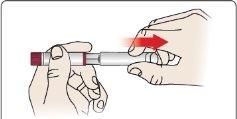
- Удалите колпачок шприца-ручки (1), потянув за него.
1/б Проверьте лекарство
- Проверьте этикетку шприца-ручки, чтобы убедиться, что у вас есть правильное лекарство и что оно не просрочено.
- Не используйте шприц-ручка Терроса, если:
- шприц-ручка поврежден.
- раствор мутный, окрашенный или содержит частицы.
1/в Установите иглу
- Возьмите новую иглу для каждой инъекции, используйте только иглы, рекомендованные в разделе «Совместимые иглы» на последней странице инструкции по применению.
- Не используйте иглу шприца-ручки, если съемная лента повреждена или отсутствует - утилизируйте ее и возьмите новую.
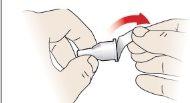
- Удалите съемную ленту (10).

- Нажмите иглу на конец шприца-ручки и завинтитеее до упора.

- Удалите внешний колпачок иглы (9) и уберитеего в безопасное место, поскольку вам понадобится удалить иглу позже. Держите внутренний защитник иглы (8) на игле, чтобы избежать случайных проколов.
- Введение
2/а Установка дозы
Ваш шприц-ручка содержит 28 фиксированных доз по 80 мкл. Эта фиксированная доза должна быть установлена для каждой ежедневной инъекции.

- Поверните кнопку регулировки дозы (6) до тех пор, пока дисплей (5) не покажет символ стрелки и рукоятка не заблокируется. Вы должны услышать щелчок, когда доза будет правильно установлена.
- Символ стрелки означает, что фиксированная ежедневная доза установлена и шприц-ручка готов к введению.
- Если вы не можете установить дозу, шприц-ручка почти пуст. Используйте новый шприц-ручка Терроса.
2/б Выберите место введения

- Используйте свой живот или верхнюю часть бедра для введения. Подготовьте свою кожу согласно рекомендациям вашего врача.
- Очистите выбранную область с помощью ватного шарика, смоченного в спирте.

- Аккуратно удалите внутренний защитник иглы (8) и сразу же утилизируйте его.
2/в Введение дозы
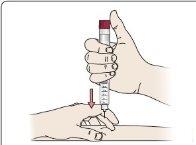
- Аккуратно возьмите складку кожи между большим и указательным пальцами.
Введите иглу прямо и аккуратно в кожу.
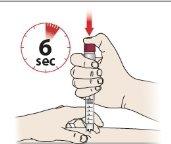
- Нажмите кнопку регулировки дозы (6) до упора и удерживайтеее не менее 6 секунд, чтобы обеспечить введение полной дозы - вы услышите щелчок, когда начнете нажимать кнопку, это нормально.
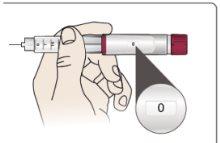
- Медленно удалите шприц-ручка. Важно: Проверьте, показывает ли дисплей «0».
- После введения
3/а Удалите иглу
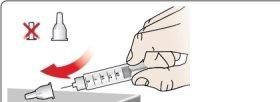
- Осторожно положите обратно внешний колпачок иглы (9), закрывая иглу (7).

- Держите внешний колпачок иглы (9) и отвинтите иглу (7).
- Всегда утилизируйте иглы безопасно, используя контейнер для острых предметов или следуя рекомендациям вашего врача.
3/б Как хранить шприц-ручка

- Положите обратно колпачок (1) на шприц-ручка.
- Сразу же после использования положите шприц-ручка в холодильник при температуре между 2 и 8 °C.
3/в Как утилизировать шприц-ручка

Когда утилизируете шприц-ручка после 28 дней использования, сделайте это осторожно и как описано в разделе «Как утилизировать шприц-ручка Терроса и использованные иглы» на последней странице инструкции по применению.
Решение проблем
Если у вас есть вопросы относительно использования шприца-ручки Терроса, следуйте инструкциям, представленным в таблице на следующей странице:
Проблема | Решение |
| Маленькая пузырек воздуха не повлияет на дозу и не причинит вреда. |
| Используйте другую иглу. Если вторая игла также не может быть установлена, свяжитесь с службой поддержки пациентов. |
| Используйте другую иглу. |
| Установите иглу. Вы увидите выход нескольких капель. Шприц-ручка снова готов к использованию. Установите дозу и введите. |
| Количество лекарства в шприце-ручке Терроса меньше 80 мкл. Используйте новый шприц-ручка Терроса. |
| Не повторяйте введение в тот же день. Используйте новую иглу для введения на следующий день. Если дисплей все еще не возвращается к положению «0» после введения, не используйте этот шприц-ручка; свяжитесь с службой поддержки пациентов. |
| Не используйте этот шприц-ручка; свяжитесь с службой поддержки пациентов. |
Дополнительная важная информация
- Предварительно заполненный шприц-ручка Терроса содержит 28 фиксированных ежедневных доз по 80 мклинъекционного раствора Терроса для лечения остеопороза.
- Не переливайте лекарство в шприц.
- Используйте шприц-ручка Терроса только так, как указал ваш врач, и в соответствии с информацией в этих инструкциях по применению и в инструкции к Терросе
- Используйте новую иглу для каждой инъекции.
- Шприц-ручка Терроса может быть использована пациентами старше 18 лет, медицинскими работниками или третьими лицами, такими как взрослые члены семьи.
- Шприц-ручка Терроса не должна быть использована пациентами с нарушением зрения без помощи обученного человека и без нарушения зрения. Проконсультируйтесь с вашим врачом, если у вас есть проблемы со слухом или манипуляциями.
Если у вас есть вопросы относительно использования шприца-ручки Терроса, пожалуйста, свяжитесь с службой поддержки пациентов.
Телефон: XXXXXXXXXX
Электронная почта: XXXXXXXX
Совместимые иглы
- Игла Clickfine калибра 29-31 (диаметр 0,25-0,33 мм) и длиной 12, 10, 8 или 6 мм.
- Игла BD Micro-Fine калибра 29-31 (диаметр 0,25-0,33 мм) и длиной 12,7, 8 или 5 мм.
Хранение и уход за шприцом-ручкой Терроса
- Не храните шприц-ручка Терроса с установленной иглой, поскольку это может вызвать образование пузырьков воздуха в картридже.
- Перевозите и храните шприц-ручка Терроса при температуре между 2 и 8 °C.
- Не храните шприц-ручка Терроса в морозильнике. Если лекарство было заморожено, утилизируйте устройство и используйте новый шприц-ручка Терроса.
- Храните шприц-ручка Терроса и иглы вне досягаемости детей.
- Обращайтесь с шприцом-ручкой осторожно. Не роняйте шприц-ручка и избегайте ударов о твердые поверхности. Защитите его от воды, пыли и влаги.
- Вы можете использовать влажную ткань для очистки шприца-ручки Терроса. Не используйте спирт, растворители или чистящие средства. Не погружайте шприц-ручка Терроса в воду, поскольку это может повредить его.
- Не используйте шприц-ручка Терроса, если он поврежден или если у вас есть сомнения относительно его правильной работы.
Как утилизировать шприц-ручка Терроса и использованные иглы
- Утилизируйте шприц-ручка Терроса через 28 днейпосле первого использования.
- Прежде чем утилизировать шприц-ручка Терроса, всегда удалите иглу.
- Поместите использованные иглы в контейнер для острых предметов или в пластиковый контейнер с крышкой. Не выбрасывайте иглы непосредственно в домашний мусор.
- Не перерабатывайте контейнер для острых предметов.
- Спросите вашего врача или фармацевта о различных вариантах правильной утилизации шприца-ручки и контейнера для острых предметов.
- Инструкции по обращению с иглами не предназначены для замены местных политик, медицинских работников или учреждений.
Владелец разрешения на маркетинг: Gedeon Richter Plc., Венгрия
Изготовлено Gedeon Richter Plc., Венгрия
Это руководство пользователя было пересмотрено последний раз

Сколько стоит ТЕРРОСА 20 микрограмм/80 микролитров раствор для инъекций в предварительно заполненной шприц-ручке в Испании в 2025 году?
Средняя цена на ТЕРРОСА 20 микрограмм/80 микролитров раствор для инъекций в предварительно заполненной шприц-ручке в декабрь, 2025 года составляет около 252.16 евро. Финальная стоимость может зависеть от региона, конкретной аптеки и рецептурного статуса. Для точной информации лучше проверить онлайн или в ближайшей аптеке.
- Страна регистрации
- Средняя цена в аптеках252.16 EUR
- Активное вещество
- Требуется рецептДа
- Производитель
- Информация носит справочный характер и не является медицинской рекомендацией. Перед приемом любых препаратов проконсультируйтесь с врачом. Oladoctor не несет ответственности за медицинские решения, принятые на основе этого контента.
- Аналоги ТЕРРОСА 20 микрограмм/80 микролитров раствор для инъекций в предварительно заполненной шприц-ручкеФорма выпуска: ИНЪЕКЦИОННЫЙ РАСТВОР, 250 микрограмм/млАктивное вещество: teriparatideПроизводитель: Gp Pharm S.A.Требуется рецептФорма выпуска: ИНЪЕКЦИОННЫЙ РАСТВОР, 250 мкг/млАктивное вещество: teriparatideПроизводитель: Eli Lilly Nederland B.V.Требуется рецептФорма выпуска: ИНЪЕКЦИОННЫЙ РАСТВОР, 20 микрограмм/80 микролитровАктивное вещество: teriparatideПроизводитель: Theramex Ireland LimitedТребуется рецепт
Аналоги ТЕРРОСА 20 микрограмм/80 микролитров раствор для инъекций в предварительно заполненной шприц-ручке в других странах
Лучшие аналоги с тем же действующим веществом и терапевтическим эффектом.
Аналог ТЕРРОСА 20 микрограмм/80 микролитров раствор для инъекций в предварительно заполненной шприц-ручке в Poland
Врачи онлайн по ТЕРРОСА 20 микрограмм/80 микролитров раствор для инъекций в предварительно заполненной шприц-ручке
Консультация по дозировке, побочным эффектам, взаимодействиям, противопоказаниям и продлению рецепта на ТЕРРОСА 20 микрограмм/80 микролитров раствор для инъекций в предварительно заполненной шприц-ручке – по решению врача и с учетом местных правил.










